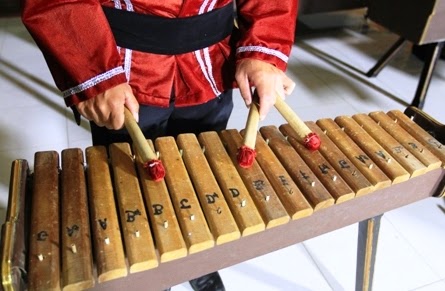Understanding Musical Instruments Fu
Musical Instruments FU (sound source: Aerofon, blown and controlled by palms as soundman). Fu is a traditional musical instrument originating from North Maluku. Fu
made of shells, and how to play by blowing. Fu was first discovered when
a person is lost and blowing shells to ask for help from others. How to
play any different though still by blowing, this was due to the
location of the holes on each of the different tools.
Function Musical Instruments Fu
Fu
music when seen at the beginning of the emergence of this type of music
then possess the function is to be played. The distinctive sound of
brass instruments is a hallmark of music fu.When
viewed in this life, then this music slowly been eroded even almost
lost its usefulness by the younger generation now. If seen now, then
this music only serves as a regional asset, which became one of the
regional wealth, but only on display in the museum original function is
not really used. However
different villages and villages Sirisori Amalatu Hutumuri which still
preserve this music so that its function remains performing well. In
this village, students in schools were taught how to blow fu musical
instruments.Music
fu basically be implemented in all schools in the city of Ambon, where
teachers apply to students, in order to support the preservation of this
music by the younger generation, who will bring this music at a later
date.
Examples
of musical instrument sounds tahuri serves as a tool in the traditional
life in the region of Central Maluku. This tool is emitted in order to
invite the presence of the ancestors in the implementation of the
ceremony. In the village Hutumuri students from 3rd grade-High School have been taught about this bia music.
Use Of Music FU
As
you know, the music came from the village Hutumuri fu, who was brought
up to be known by almost the wider community. The use of music is still
stable Fu done is in the village of Sirisori Amalatu Hutumuri and
villages, where these two villages Music Fu taught to the young
generation at the school level. But
not many people know the kind of music Fu. In urban areas, people who
know the music Fu can be counted on the fingers, the older generation
who have lived a long time so knowing fu music. But in fact the younger
generation in urban areas did not know what the fu music.
Use
of Music Fu was very minimal. Music Fu also less performing than modern
instruments. This is because not many people know what kind of music
that fu. Musical instruments for this kind of music fu bia made of leather or snails. How to use fu music is by blowing. As is known, this type of wind instruments are numerous, including:
- Skin Bia Tataratol
- Skin Bia Capeu
- Skin Bia Tahuri
- Skin Bia Lemon
How to play it was different though still by blowing, this was due to the location of the holes on each of the different tools.
Local Opinions About Musical Fu
This
is a music instrument music instrument that has unique characteristics,
namely the shape and sound is generated and also the basic material of
this music, Leather Bia. Society found music instrument development is
still slow and is developed Deming must preserve this instrument. In
1958. At that time Mr. Latumahina read a history book, and then he saw a
moderate blow bia skin, then he went to the village Hutumuri, at that
time the king was King Wellem Tehupiong, when the country was still a
long Hutumuri. And
at that time you go to the mountain Latumahina death, he used the
official outfit, so he can not go up. Finally he changed clothes with
traditional fabrics that can go up to the mountain. In
the years 1960-1963 the group ' Pela Nyong ' go to Jakarta for the
opening along with Mr.PON. Latumahina to blow tahuri there. In 1964
when she returned from Jakarta them to hand over all skin bia to
Amahusu.
Similarly, a brief history of the origin of Fu musical instrument we know today. Thank you for visiting my blog :)









